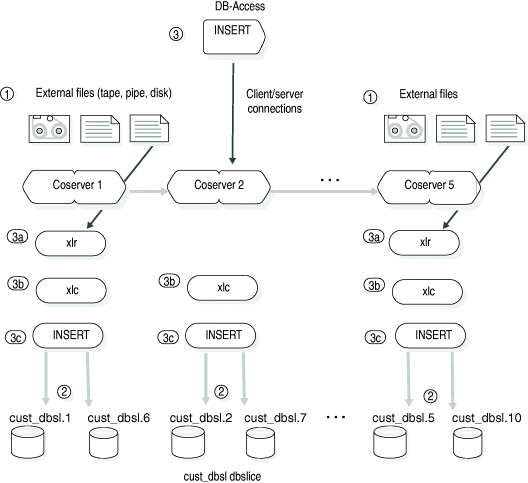Home |
Previous Page | Next Page Disk, Memory, and Process Management > Loading with External Tables for Extended Parallel Server > Getting an Overview of High-Performance Loading >
To map external data to internal data, the database server
views the external data as an external table.
Treating the external data as a table provides a powerful method
for moving data into or out of the database and for specifying transformations
of the data.
When the database server runs a load task, it reads data from
the external source and performs the conversion required to create
the row and then inserts the row into the table. The database server
writes errors to two places:
- The reject file
- The violations table
Using the Reject File and Violations Table to Handle Load
Errors
If the data in the external table cannot be converted
or violates check constraints, you can specify that the database
server write the record to a reject file,
along with the reason for the failure. To
do this, you specify the REJECTFILE keyword
in the CREATE EXTERNAL TABLE statement.
For more information, see Reject Files.
During a load, rows that violate unique or referential constraints
are recorded in a violations table. During
an insert, update, or delete operation, any type of constraint violation
gets recorded in the violations table. The bad row is sent to the
violations table, permitting the load to continue successfully. For
information on starting a violations table, see the IBM Informix: Guide to SQL Syntax and Loading Data in Deluxe
Mode.
Setting Up Loading and Unloading Tasks
To set up loading and unloading tasks, you issue a series
of SQL statements:
- CREATE EXTERNAL TABLE to describe the
data file to load or unload
- CREATE TABLE to define the table to
load
- INSERT...SELECT to load
A second method, which uses a SELECT...INTO EXTERNAL statement,
is also available for unloading data to an external table. For more
information about these SQL statements
and the violations table, see the IBM Informix: Guide to SQL Syntax.
Figure 76 shows the relationship
of these SQL statements to the load process. The following
steps outline the load process:
- The CREATE EXTERNAL TABLE statement
describes the location of the various external files, which can
be on disk or come from a pipe (tape drive or direct network connection),
and the format of the external data.
The following sample CREATE EXTERNAL TABLE statement
shows that the data files exist on coservers in the cogroup_cust cogroup,
which consists of coservers 1 and 5:
CREATE EXTERNAL TABLE emp_ext
( name CHAR(18) EXTERNAL CHAR(18),
hiredate DATE EXTERNAL CHAR(10),
address VARCHAR(40) EXTERNAL CHAR(40),
empno INTEGER EXTERNAL CHAR(6) )
USING (
FORMAT 'FIXED',
DATAFILES
("DISK:cogroup_cust:/work2/mydir/emp.fix")
);
- The CREATE TABLE statement defines
the table to load.
The following sample CREATE TABLE statement
defines the customer table in the cust_dbsl dbslice:
CREATE TABLE customer
(cust_id integer,... )
FRAGMENT BY HASH (cust_id)
IN cust_dbslc;
Figure 76 shows that the cust_dbsl dbslice
consists of ten dbspaces, with two dbspaces on each of the five
coservers.
- The INSERT...SELECT statement maps
the movement of the external data from or to the database table.
The following sample INSERT statement
loads the customer table from the external
table to the cust_dbsl dbslice:
INSERT INTO employee SELECT * FROM emp_ext
The INSERT...SELECT statement uses the
multithreaded architecture of the database server to perform the
load process in the following steps:
- Execute multiple read operations from
tapes, files, or pipes. In this example, coservers 1 and 5 contain
data files. During the load process, the xlr (xload load reader)
operators on coservers 1 and 5 read each data file.
- The Data Flow Manager ships the data from the xlr operators
to the xlc (xload load converter)
operators on coservers 1 through 5. The xlc operators
convert the data in parallel.
- Load multiple fragments of the table in parallel. The load process
has a separate INSERT operator per fragment.
Figure 76. Overview of Load Process
Home |
[ Top of Page | Previous Page | Next Page | Contents |
Index ]
